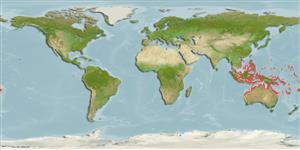Common names from other countries
Environment: milieu / climate zone / depth range / distribution range
Ekologi
; kisaran kedalaman 0 - 20 m (Ref. 348), usually 0 - 15 m (Ref. 75831). Tropical; 23°C - 30°C (Ref. 102835); 19°N - 34°S, 100°E - 174°W (Ref. 106696)
Indo-West Pacific.
Length at first maturity / Size / Weight / umur
Maturity: Lm ? range ? - ? cm Max length : 60.0 cm SHL jantan/; (Ref. 348); common length : 50.0 cm SHL jantan/; (Ref. 348)
It is characterized by a low primary and radial sculpture, variable shape, massive umbonal area and smooth white shell.
Locally exploited for meat and shell. This species was previously quite abundant, but has been over collected in many areas. Aquaculture attempts being made (Ref. 348). Found in intertidal areas on corals (Ref. 75831), mainly on reef flats, barrier reefs, fore reefs and atoll lagoons (Ref. 117184). Common in shallow waters wherein juveniles are byssally attached to the tops and sides of coral outcrops. Adults are thought to detach their byssus and settle in clear ocean conditions at 20 m depth (Ref. 101207).
Life cycle and mating behavior
Kematangan | Reproduksi, perkembang biakan | Pemijahan | telur-telur | Fecundity | Larva
Life cycle: Embryos develop into free-swimming trocophore larvae, succeeded by the bivalve veliger, resembling a miniature clam (Ref. 833).
rujukan utama
Acuan | Koordinator | mitra
SAUP Database. 2006. (Ref. 356)
Status IUCN Red List (Ref. 130435)
status CITES (Ref. 108899)
Not Evaluated
penggunaan manusia
Perikanan: komersial
FAO - Budidaya air: production; | FishSource | Sea Around Us
Alat, peralatan
Sumber internet
Estimates based on models
Preferred temperature
(Ref.
115969): 24.7 - 29.3, mean 28.6 (based on 2248 cells).
Daya lenting
Rendah, Waktu penggandaan populasi minimum 4.5 - 14 tahun (K=0.11-0.11; tm=4).
keancaman
High vulnerability (64 of 100).
kategori harga
Unknown.
